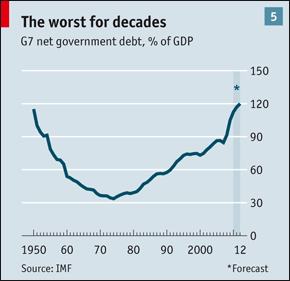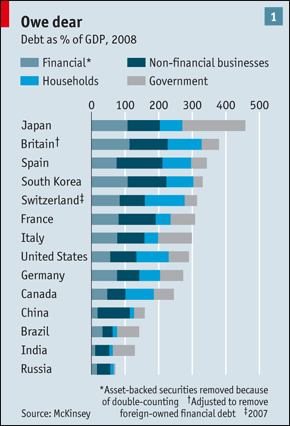Chart(s) of the day: Old Core debt at WWII-era levels
 Monday, July 12, 2010 at 12:01AM
Monday, July 12, 2010 at 12:01AM  Two from The Economist on Old Core debt.
Two from The Economist on Old Core debt.
First one shows how we’ve collectively returned to the public debt levels, as a percentage of GDP, that we had coming out of World War II—roughly 120%.
Well at least it took the biggest global economic crisis since the Great Depression to achieve it.
Why it may prove much harder this time to whittle it down: personal and industrial and financial sectors are much more indebted now.
 When all of those sectors are added together, the US is in the middle of the pack, as the second chart shows, behind Japan, Britain, Spain, South Korea, Switzerland, France and Italy. Collectively, the nation owes 3 times its annual GDP.
When all of those sectors are added together, the US is in the middle of the pack, as the second chart shows, behind Japan, Britain, Spain, South Korea, Switzerland, France and Italy. Collectively, the nation owes 3 times its annual GDP.
On households, I’m assuming they’re only counting the “underwater” portion of mortgages (the non-asset-backed portion).
The usual underlying logic on assuming debt that’s not asset-backed is that future growth will allow you to pay it off. But as The Economist warns, that’s perhaps a very poor bet in societies experiencing profound aging.










Reader Comments (2)
I'm fairly certain that your assumption that household debt only includes the "underwater" portion of mortgages is incorrect. In Canada the mortgage rules act as a significant constraint on the creation of such mortgages. And Canada has about the same level of household debt as the U.S.
I don't think they charts are concerned with the quality of the debt, and whether it is backed by an asset that generates income (real or virtual), but instead are focused purely on the total amount.
While the economists continue to entertain us with their mental gymnastics and our politicians, most of which couldn't balance a checkbook, try to explain deficit reduction/spending to the unwashed masses, demographics trump all.
Approx. 10,000 people in the US retire daily. All of whom are effectively becoming wards of the state. There isn't any amount of population growth or reasonable taxation that will offset their drain on society.
It will be interesting to see how the deficit hawks respond to a population that is completely set on the idea of retiring at the age of 62. Most of whom based their finances on asset appreciation(home values). And right now, that doesn't look so good.